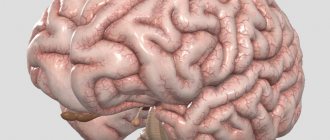Brain cancer is a dangerous disease that is difficult to treat and can lead to the death of the patient. The greatest threat lies in its asymptomatic course - the fourth stage of brain cancer, in which the patient has severe symptoms of the disease, is difficult to treat and the prognosis for such patients is disappointing.
At the same time, the symptoms with which a patient may consult a doctor can easily be confused with manifestations of other diseases. Thus, headaches, vomiting and dizziness in combination with visual impairment are characteristic of migraine and hypertensive crisis. Head pain can also be caused by osteochondrosis. Therefore, in the treatment of brain cancer, much depends on the qualifications of the doctor who is consulted for diagnosis - whether he will be able to detect dangerous signs in time and conduct the necessary examination, which will help identify the oncological process.
Tumors are classified according to the tissues in which they begin to grow. Thus, tumors developing from the membrane of the brain are called menangiomas. Tumors that arise in brain tissue are gangliomas or astrocytomas, the common name is neuroepithelial tumors. Neuroma is a malignant neoplasm affecting the sheath of the cranial nerves.
Gliomas make up 80% of malignant brain tumors; meningiomas are also common tumors, occurring in 35% of cases of primary brain cancer.
- Surgery
- Gamma Knife - targeted radiosurgery
Primary and secondary brain tumors
A tumor is called primary if it originally arose in the brain. Actually, this type of cancer will be discussed in this article. Secondary tumors are metastases in the brain that have spread from other organs. Most often, bladder, breast, lung, kidney, lymphoma, and melanoma cancers metastasize to the brain. Often, lesions in the nervous system are found in lymphomas. Secondary brain tumors are much more common than primary ones.
You can hear the term “brain cancer” very often. It's not entirely correct to say that. Cancer is just one of the types of malignant tumors, those that develop from epithelial (integumentary) tissues. Other types of benign and malignant neoplasms develop in the central nervous system. Strictly speaking, it's not cancer. Most often we are talking about glioma and its more malignant variant - glioblastoma. It accounts for up to 60% of all cases. As the name suggests, such tumors originate from glial cells, which fill the space between neurons, participate in their regeneration, metabolism, and help in conducting nerve impulses.
Depending on the type of cells that make up gliomas, they are divided into astrocytomas, oligodendrogliomas, and ependymomas.
Stages
Staging is a determination of where the cancer is located, whether and where it has spread, and its effect on other parts of the body.
Doctors use diagnostic tests to determine the stage of cancer; they may need information based on tissue samples obtained at surgery, so staging may continue until all tests are completed. Information about the stage helps the doctor determine which treatment is optimal and predict the possibility of recovery.
TNM tumor classification system
One way to determine the stage of cancer is the TNM system. Doctors use the results of diagnostic tests and scans to answer questions such as:
- Tumor (T): its size and location?
- Lymph nodes (N): extent of spread of the process to the lymph nodes?
- Metastasis (M): Has the cancer spread to other parts of the body?
The results are combined to determine each patient's cancer stage. Stage provides a common way to describe cancer so doctors can work together to plan the best treatment.
Why do tumors appear in the brain?
The exact causes of malignant brain tumors, like other cancers, are unknown. There are many risk factors that increase the likelihood of developing the disease:
- The tumor can occur at any age, but older people are most often affected.
- The risks are increased in people who have been exposed to ionizing radiation. Most often this is associated with radiation therapy for other cancers. In the course of the studies, no connection was found between brain tumors and radiation from power lines, mobile phones, and microwave ovens.
- Heredity plays a certain role. If your close relatives have suffered from malignant brain tumors, your risk is also increased.
- Men get sick more often than women.
- There is an opinion that the risk of getting sick increases with frequent contact with toxic substances: pesticides, solvents, vinyl chloride, some rubbers, and petroleum products. But there is no scientific evidence.
- The causative agent of infectious mononucleosis, Epstein-Barr virus, is associated with an increased risk of brain lymphoma. Cytomegaloviruses have been found in some tumors; their role remains to be studied.
- The role of traumatic brain injury and severe stress is not entirely clear. They may also be risk factors, but this has not yet been proven.
Having one or even more risk factors does not guarantee that a person will be diagnosed with a brain tumor. Sometimes the disease develops in people who have no risk factors at all.
Lifestyle
After treatment for brain cancer, many changes occur in a person's life. He really needs the support of friends and family, help in adaptation. It may be necessary to adapt home conditions to the person’s needs, and at first help with household tasks.
You will have to give up contact sports that can lead to head injuries (boxing, volleyball). It is not recommended to swim alone for about one year due to the high risk of seizures.
After treatment, rehabilitation and a doctor’s report, you can return to driving.
Women are advised to refrain from conceiving a child for 6 months after completion of treatment. There are no restrictions for sexual relations.
Development of malignant brain tumors
Primary tumors arise directly in the brain or in structures that are nearby:
- Meninges.
- Cranial nerves.
- Pituitary gland (pineal gland).
The general mechanism for the development of tumors in the brain is that “wrong” cells appear in which DNA mutation occurs. Some mutations cause cells to multiply uncontrollably and develop defenses against the immune system and the natural mechanism of cell death.
What are the symptoms of brain tumors?
Symptoms are nonspecific, they resemble manifestations of other diseases. It is important to be attentive to your health. You need to pay attention to any new, uncharacteristic symptoms. Their occurrence is a reason to visit a doctor and get checked.
The most common signs of malignant brain tumors are:
- Headaches, especially if they appeared for the first time or became different from before, if they bother you more and more often and become more severe.
- Nausea and vomiting for no apparent reason.
- Visual impairment: loss of sharpness, double vision, peripheral vision disorder.
- Convulsive seizures that occurred for the first time.
- Numbness, impaired movement in a certain part of the body.
- Speech, memory, behavior, personality disorders.
- Hearing loss.
- Unsteadiness of gait, impaired sense of balance.
- Increased fatigue, constant weakness, drowsiness.
All these symptoms are due to the fact that the tumor is growing and putting pressure on the brain. Manifestations in a particular case will depend on the size of the lesion, where it is located, and which parts of the brain are located nearby.
Introduction
Cancer begins when healthy cells change and begin to grow uncontrollably, forming a mass called a tumor. A tumor can be cancerous or benign. A cancerous tumor is malignant, meaning it can grow and spread to other parts of the body. A benign tumor may grow but not spread to other tissues.
Head and neck cancer
Head and neck cancer is a term used to describe a number of different cancers that develop in or in the throat, larynx, nose, sinuses and mouth.
Most head and neck cancers are squamous cell carcinomas. This type of cancer begins in epithelial cells, which make up a thin layer of surface tissue. Just below the epithelium, in some areas of the head and neck, there is a layer of moist tissue called mucosa. If cancer is found only in the squamous cell layer, it is called carcinoma in situ. If the cancer has grown beyond this cell layer and into deeper tissue, it is called invasive squamous cell carcinoma.
When head and neck cancer begins in the salivary glands, the tumor is usually classified as adenocarcinoma, adenoid cystic carcinoma, or mucoepidermoid carcinoma.
Types of head and neck cancer
There are 5 main types of head and neck cancer, each named according to the part of the body where it is found.
- Laryngeal cancer and hypopharyngeal cancer. The larynx is an integral part of the vocal apparatus. This tubular organ in the neck is used for breathing, speaking and swallowing. It is located at the top of the windpipe, or trachea. The hypopharynx (esophagus) is the lower part of the throat, surrounded by the larynx.
- Cancer of the nasal cavity and paranasal sinuses . The nasal cavity is the space behind the nose where air enters the throat. The paranasal sinuses are the air-filled areas surrounding the nasal cavity.
- Nasopharyngeal cancer. The nasopharynx is the air cavity at the top of the throat behind the nose.
- Cancer of the oral cavity and oropharynx . The oral cavity includes the mouth and tongue. The oropharynx includes the middle of the throat, from the tonsils to the tip of the voice box.
- Salivary gland cancer . The salivary gland produces saliva. Saliva is a fluid that is secreted in the mouth to maintain moisture and contains enzymes that break down food.
Other types of cancer can also be localized in the head and neck area, but their diagnosis and treatment are very different.
How are brain tumors diagnosed?
Typically, a person who begins to be bothered by symptoms from the list above first of all turns to a neurologist. The doctor listens to the patient’s complaints, checks reflexes, muscle strength and sensitivity, and tries to detect neurological symptoms and signs of dysfunction in certain parts of the nervous system. If a patient complains of visual or hearing impairment, he is referred for consultation to an ophthalmologist or ENT doctor.
Magnetic resonance imaging, including its modifications, is the best way to detect tumors and other formations in the brain:
- MRI with contrast.
- Functional MRI helps assess the activity of a particular area of the brain.
- Perfusion MRI is a study that involves injecting a contrast agent into a vein to evaluate blood flow in the brain.
- Magnetic resonance spectroscopy helps to evaluate metabolic processes in a particular area of the brain.
Computed tomography and positron emission tomography are also used. They help detect metastases in different parts of the body.
A biopsy helps to distinguish a benign formation from a malignant one and assess the degree of malignancy - taking a piece of tissue and then examining it under a microscope. A biopsy can be performed using a needle under CT or MRI guidance.
Types of oncology
Brain oncology in adults is divided into two forms: malignant and benign formations.
Benign formations are characterized by clear boundaries and covering with dense connective tissue, thereby forming a capsule. This species does not form metastases and completes its growth in a certain phase, sometimes without showing itself; the functioning of the brain often remains unchanged.
When the vessels of the skull are compressed, benign oncology is successfully removed surgically, since the altered tissues are separated from healthy cells. Small tumors do not require surgical interventions; periodic monitoring of the formation is carried out.
Malignant neoplasms in the brain intensively increase their size, pinching nearby vessels and tissues. Cancer manifests itself as an acute disruption of the activity of the brain and other organs, as it forms metastases, penetrating into them through the bloodstream.
Atypical cell proliferation typically affects large areas of the brain. This type of oncology has unclear boundaries, as a result of which it is not possible to separate the pathological focus from healthy cells.
Treatment of brain tumors
The choice of treatment methods depends on the type, size, location of the tumor, and the patient’s health status. Surgery (including radiosurgery), radiation therapy, chemotherapy, and targeted therapy are used.
Surgery
Some tumors have a convenient location and are easily separated from healthy tissue; in such cases, surgical treatment is resorted to. If the tumor is close to important brain structures, deep, and difficult to reach, your doctor may try to remove some of the brain tumor. This often helps greatly relieve symptoms.
Stereotactic radiosurgery
Radiosurgical treatment, strictly speaking, does not apply to surgical techniques. Rather, it is a type of radiation therapy. It can be used to remove small brain tumors. To explain it in simple words, the essence of the method is that the patient’s body is irradiated from all sides with small doses of radiation. All rays converge at the point where the focus is located, it receives a large dose that destroys it. At the same time, the surrounding healthy tissue remains intact.
There are different devices for stereotactic radiosurgery, one of the most popular in Russia is the gamma knife.
Radiation therapy
For brain tumors, various modifications of radiation therapy are used. Irradiation can be targeted at the focus or the entire brain. The second option is used for secondary cancer in order to destroy all possible metastases.
Chemotherapy
The most commonly used chemotherapy drug for brain tumors is temozolomide (Temodar). There are others too. Main indications for chemotherapy:
- After surgery (adjuvant chemotherapy) to destroy remaining tumor cells and prevent recurrence.
- In case of relapse after surgery, often in combination with radiation therapy.
- In order to slow down the growth of the tumor.
- To combat symptoms.
The effectiveness of chemotherapy is monitored using regular MRI scans. If the lesions continue to grow during treatment, this indicates that the drugs are not working.
Targeted therapy
Targeted drugs act more precisely than chemotherapy drugs. They block certain substances in tumor cells, thereby interfering with their reproduction and causing death. For malignant brain tumors, bevacizumab (Avastin) is used, a targeted drug that blocks angiogenesis (the formation of new blood vessels that provide the tumor with oxygen and nutrients).
Diagnostics
For diagnostic purposes, MRI, CT, angiography, neurological examination methods, radioisotope methods for studying the tumor, stereotactic biopsy and ventriculoscopy are used. To confirm an oncological diagnosis, a lumbar puncture is often used.
It happens that a large tumor is completely asymptomatic, and a formation several millimeters in size has obvious and typical symptoms.
It is almost impossible to independently detect the disease based on its symptoms, since the tumor is localized deep inside the skull.
Rehabilitation
The tumor can affect areas of the brain that are responsible for important functions, such as speech, movement, sensory organs, thinking, and memory. Therefore, many patients need a course of rehabilitation treatment. It may include different activities, for example:
- Classes with a speech therapist, speech therapy.
- Individual training, classes with a tutor for schoolchildren and students.
- Physical therapy helps restore motor skills.
- Occupational therapy, career guidance, and, if necessary, training in a new profession.
- Drugs that help cope with tumor symptoms and side effects of treatment: drugs to improve memory, combat fatigue, etc.
After successful treatment, a relapse may occur, so it is important to regularly visit your doctor for examinations and undergo an MRI.
Survival prognosis
The prognosis for brain tumors depends on several factors:
- Features of the histological structure of the tumor, degree of malignancy.
- Neurological status, nature and severity of disorders of the nervous system.
- Patient's age.
- Location of the tumor.
- The amount of tumor tissue that remains after surgery to remove a brain tumor.
The effectiveness of treatment is assessed by the 5-year survival rate - the percentage of patients who remain alive 5 years after their tumor was diagnosed. For malignant brain tumors, this figure varies greatly, averaging 34% for men and 36% for women.
Book a consultation 24 hours a day
+7+7+78











